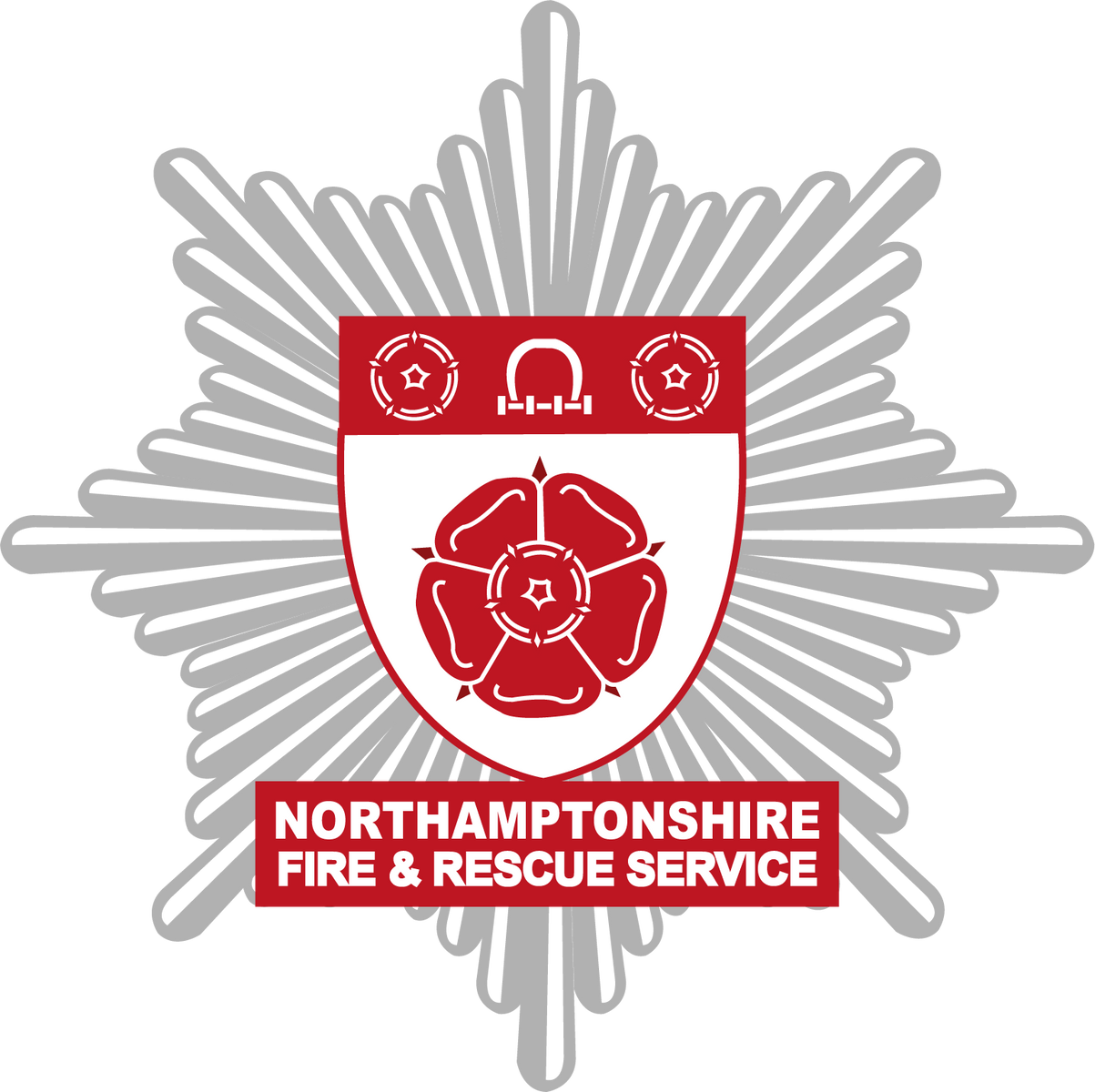The history of Northamptonshire Fire and Rescue Service
The history of Northamptonshire Fire and Rescue Service (NFRS)
NFRS was formed in 1974 when the Northamptonshire Fire Brigade and Northampton Borough Fire Brigade merged together. We have 22 fire stations within Northamptonshire which include Wholetime Duty System Stations (24/7 crewed), Retained Duty System Stations (On-Call crewed) and Variable Crewing System stations.
For more information on the history of Firefighting, please visit our page ‘history of the Fire Service’
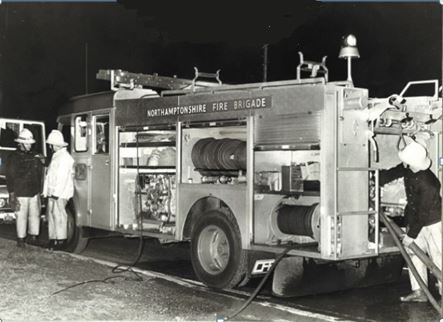
Facts and information
Back in 1980, Northamptonshire Fire Brigade had an increase of emergency calls with the final figure of 4,435. At this time fire losses rose to £469 million, this cost represents only the direct loss of property and goods burned, not including substantial consequential losses such as production or employment. Loss of life in fire had increased comparing statistics for the previous 15 years where the highest number was 780 fatalities which had now jumped to 1,096 as of 1979. Identifying risks became paramount to preventing fires as the majority of house fires were caused by men, women and children making common human errors in the home. There was a need to keep the public informed of the dangers of fire and fire setting and some of the simplest precautions could lead to a large effect on preventing loss.
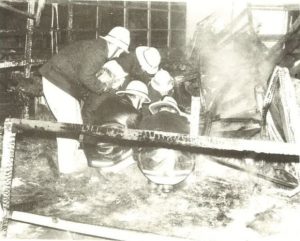
NFRS strive to improve and make positive changes to support our community.
If you have any information or pictures you wish to share with us, please contact us.
Rushden Fire Brigade was founded in 1877 with only twelve men under the Captaincy of William Foskettt. The Brigade started from the purchase of a Shand Mason Manual Fire Engine.
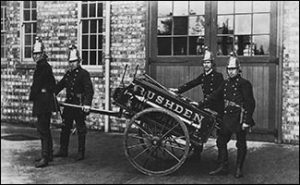
Foskett’s second officer was Fred Knight (see image below) who was then appointed Captain in 1885, Knight served in this position for 35 years.
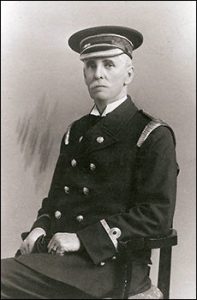
The first Station was situated in “Butcher Smith’s Yard” opposite the entrance to Hall Park on the corner of Griffith Street.
At this time, the method of calling the Brigade was to ring the Number 5 bell inside St. Mary’s Church. Compared to this day and age’s process, this was very slow as horses then needed to be obtained to arrive to an incident.
The Brigade moved to the High Street opposite West Street. A barn was rented from Dr. E. K. Freeman for a yearly fee of £7. Horses were kept on the opposite side of the road at the rear of the public house named “Feathers” which were supplied by the landlord at that time, Mr Fred Ette.
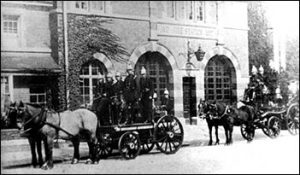
Whilst the Brigade were stationed from the High Street, a call out was made for the “Great Fire” of Rushden. The factory of John Caves set alight on the 19 July 1901 which then burnt for three days. This factory was the largest in Rushden and was the home to approximately 1,000 employees. The factory had been destroyed along with one other factory, one school, sixteen shops and twelve houses which were all burnt to the ground. Firefighters were near helpless due to the only resources at that time being a water supply from brooks and soft water wells.
In 1893 the Captain applied to the Rushden Local Government District Board for a hose cart and ladders. This was approved at a cost of £10 for the cart and £4 for the ladders. The hose cart was provided with a standpipe, key and bar, and six lengths of hose. This equipment was much needed to enable firefighters to be more competent during incidents.
Mr Claude Green was appointed caretaker of the Fire Engine House in 1895, in return he was paid £8 per annum. Claude resigned in 1942 after a 54 year service with the brigade.
Subsequently from the fire of John Caves in 1901, it was decided to build a new Station on Newton Road. It cost £150 to purchase the land which the new station was built on. This new building was designed by Mr W. B. Madin who was at the time a Urban Council surveyor and an ex fire fighter.
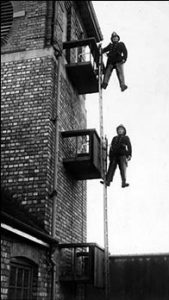
The hose tower was built 47 feet high and attached to the cottage designed to harmonise with the station and have direct access. The overall design was many years ahead of its time and also included an extension at the rear of the building in 1952. The building since has hardly changed from the original designs.
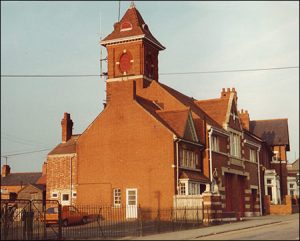
The new Station cost just shy of £1,580 however it was never officially opened. Firefighters moved into the building in July 1902. 1903 saw the station connected to the National Telephone System whereby electric bells were rung by a hand operated generator and rang in the firefighters houses.
The Shand Mason escape was bought in 1900 then in 1907 the Fire Service purchased The Shand Mason Steam Fire Engine. Twelve years on, The Schneider Motor Tender was purchased and the chassis was built in Rushden where you will now find ‘Home Bargins’. The Dennis “Ace” was purchased in 1927, a generous lady named Mrs Clara Groome (of Park Road) lent the Council £920 for the purchase of this.
Mr Fred Knight resigned in 1919 after 42 years service, his son Mr Robert F Knight succeeded him (see image below)
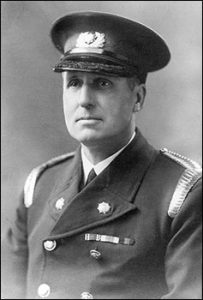
Mr Robert Knight resigned in April 1936 and Mr Albert Percy Timpson succeeded him (see image below)
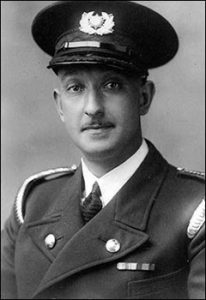
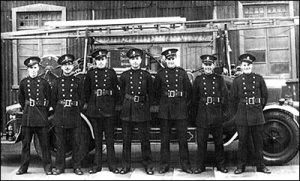
(Above: Burton Latimer Fire Brigade 1942)
L- R: Pete Barlow, Frank Clipston, Gilbert Neville, Jack Oram, Bill Griffith, Fred Toseland and Ron Coleman. The Dennis fire engine now has pneumatic tyres)
Burton Latimer station similarly to Rushden station obtained a Shand Mason horse-drawn appliance approximately from 1901 which was used until May 1914 when manual appliance built by Shand Manson was purchased and delivered to Burton Latimer’s Parish Council. This was when the new fire station was opened in Duke Street.
In the Kettering Leader newspaper dated 23 January 1914, it was reported that Burton Latimer Parish Council were considering a loan of the fire appliance from Kettering Urban District at the cost of £5 per annum. This proposal is believe to be an agreement whereby Kettering’s steamer appliance would be made available to attend any large fires in the Burton Latimer area. This would provide extra cover/assistance to Burton Latimer’s manual pump. Rothwell Council also considered the same idea shortly after experiencing a large fire.
A new appliance had been approved which saw a 16 person machine, meaning that 16 individuals would be needed to run this, including 8 men each side to pump the handles. Usually this would be the job for bystanders at the scene, any bystanders who took part would receive payment from the Fire Station once the fire was extinguished. The new appliance had the potential of pumping 62.3 gallons of water per minute if pumped at 55 double strokes (one up and one down), compared to today’s average 500 gallons per minute. The appliance also carried a short ladder for rescues. Although this was a massive leap in development there were setbacks; in order for the appliance to work it had to be set into a water supply before the hoses could work also, horses were still required to pull this therefore individuals had to fetch the horses from their fields which could potentially be a distance from the station causing delays in arriving on scene.
At the same time as this manual pump being used, the hose cart also turned out to incidents. In other areas, the hose cart would be the first appliance to be taken to a fire and this was pulled by hand. The hose cart is believed to have contained a standpipe for connecting into the street water mains, as well as a hose and branch. The hose cart was in order to assist the firefighters to begin control of the fire prior to the arrival of the manual pump appliance. There is no solid evidence to confirm that the hose cart was used this way at Burton Latimer however evidence shows this was used at Kettering. In later years the hose cart was used for competition drills between stations. The winner of each station was presented with a cup, Burton Latimer have one displayed in their station.
Burton Latimer acquired two other motorised appliances after a demonstration was held at their station by the Council in 1927 (these two appliances are thought to have been from Kettering). The demonstrations involved one display of pumping water from the mains and pumping water from open water. Burton Latimer went onto purchase a new appliance that was motorised and manufactured by the company Dennis. It was delivered in May 1928 and included an open top, spoked wheels and solid tyres. The appliance showed great improvements and featured an “Ajax” double extension ladder. Years later the wheels were changed to solid rims and the tyres were changed to pneumatic tyres. In May 1949, the appliance was sold to a scrap dealer in Finedon along with similar pumps from Wellingborough, Irthlingborough and Desborough at the total price of £84 for all four. The appliance was replaced with an Austin A40 and trailer pump (registration number: GXG301). Again fitted with an “Ajax” ladder but also had a water tank in the rear. Improvements were being made across the County to include the best equipment for saving lives. This pump was fulled enclosed so the crew now had protection from all elements whilst dressing in the rear and for the driver and officer in charge within the cab. Although all members of the crew had adequate room for travel, they only had one small window each side of the appliance which was not easy to look through.
The next appliance for Burton Latimer came in the late 19-50’s which was a Bedford appliance (registration number RNV196). Burton Latimer utilised this appliance until 1974 where it was transferred to the new station in Pigotts Lane for a short while before being replaced. The appliance had only one set of doors each side of the cab crew with the officer in charge and driver having to climb over to get to the front of the cab.
Another Bedford appliance (registration number LRP554E) was sent to Burton Latimer station in 1974 until approximately 1980. The appliance was of a standard design for a water tender which included a 500 g.p.m pump, a 10.5m double extension ladder, a 5m short extension ladder, roof ladder, various hoses and equipment. A portable pump was also carried which was capable of pumping 250 g.m.p.
Next another Dennis appliance (registration number TVV 356K) was transferred from the Mounts and this was classed as a major pump which is capable of pumping 1000 g.m.p through four deliveries. The suction hose was 5″ diameter compared to the normal 4″. This was to provide extra lift when working from open water. The standard appliances usually have a red cab and silver bodies but the Dennis was red all over. Also the Dennis doors were hinged at the top and had to be lifted by hand.
The engine in the Dennis was a Rolls Royce 8 cylinder petrol engine, giving plenty of power but using a lot of fuel. The Dennis was then removed from the Service between 1985/1986 following major engine failures.
Next, another Bedford appliance arrived (registration number ONH 769V) which was used by Burton Latimer crew until 1990/1991.
The next appliance to arrive was a Dodge appliance (registration F110 CBD) which was of standard design but updated with a 13.5m ladder. This appliance was used at Burton Latimer until 2001.
The appliance used currently is another Dennis (registration number LI03 JRP). Improvements can be shown with the recent pumps to include a lot of new equipment and protection materials. The Fire Service are utilised not only for fires, but for other services such as Road Traffic Collisions (RTCs) which means we require to carry move innovative Equipment.
For more information regarding NFRS appliances, please see our fleet list.
The Old fire station was built in 1887 and sits within a conservation area. The station is filled with local firefighter memorabilia such as helmet’s, jackets, hoses and an axe.
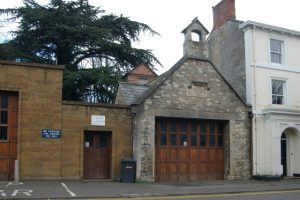
The Old fire station opened as a Cafe in February 2017 after the building was purchased from the National Trust by Brackley Town Council who then renovated it.
The Mounts fire station was opened in Northampton in July 1935.
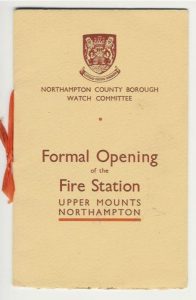
Prior to this opening, the town fire station was located at Dychurch Lane at the centre of Northampton town. Northampton Fire Brigade grew and had transitioned from manual and horse-drawn appliances to larger motor vehicles. Therefore more space was needed to house our crew and appliances. Dychurch Lane was very narrow and it became more difficult for our pumps to ‘turn out’ to an incident. It was apparent that Northampton needed a new fire station. It was proposed that the new fire station would be built near the centre of town on the ‘Mounts’ next to the old prison.
The Mounts fire station was completed, there stood a majestic building which caught the eye of many. The Mounts station does not look much different today than when it first opened.
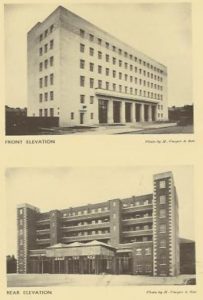
The Mounts fire station was the home of the Northampton Fire Brigade until 1976 when it was amalgamated with the Northamptonshire Fire Brigade.
Cynthia (Cyndy or Cyd) Bernadette Phillips was born and brought up in Irthlingborough Northants.
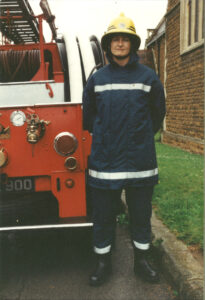
Her parents were Dutch immigrants who came to the UK to escape from the effects of WWII. She went to school in Wellingborough and joined the Post Office after school, while working as a Postie she overcame the barriers presented to her at the time and became the first Retained Firefighter Nationally in 1981.
Cyndy has three children, all of whom were born as she served as a Watch Manager (Sub-Officer at the time). Her children are two girls, Storm and Morgan Phillips and her son Arend Phillips.
Course and promotion dates:
Joined RDS on-call in 1981
17 September to 14 December 1984: West Midlands Fire Service Recruits Training School Course.
25 July 1986: Fire Services Central Examinations Board, having already passed Part I (the written technical papers), completed the Examination by passing Part II (the practical test) Qualified for promotion to the rank of ‘Leading Fireman’
12 to 26 June 1987: ‘Firewoman Phillips’ passed the NFRS Brigade Junior Officer’s Course
9 October 1987: Fire Services Examination Board, having passed Part 1 (the written papers), completed the examination by passing Part II (the practical test) Qualified for promotion to the rank of Sub-Officer
9 July 1989 to 18 August 1989: The Fire Service College Junior Officer’s Course. Cyndy achieved the second highest mark of the course and received a certificate from the Commandant of the Fire Service College G Clarke, to personally certify the fact Cyndy was the first British Wholetime Female Firefighter to attend a course at the College.
2 August to 21 August 1992: The Fire Service College Breathing Apparatus Instructor’s Course BAI, Cyndy specialised in Sabre Centurion BA sets.
Cyndy worked tirelessly to establish a network and bring women’s issues to the forefront of Fire Service development.
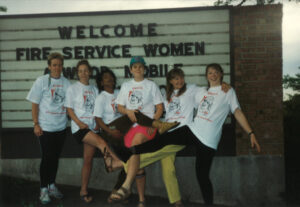
She was on the 2000 MBE New Years Honours List for services to the British Fire Service and on 18 April 2008, was awarded “Networking Women in the Fire Service Gold Award” In Recognition of her determination and leadership in setting up and developing the network.
Cindy retired due to ill health after twenty years serving in the Fire Service for twenty years.
